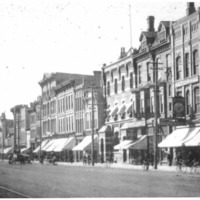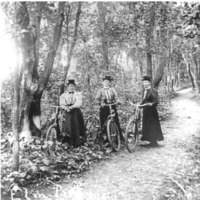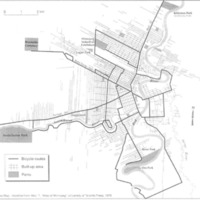Bicycles: A Symbol of Middle Class Soft Power
Cycling through the City
Bicycles in the 1890s through 1900s formed a popular mode of conveyance for middle to upper class Winnipeggers. Bicycles inclusion in this project is done so to demonstrate the continued favour afforded to the middle and upper class over working class people of Winnipeg. After initially being banned in the city limits in 1884 bicycles would later be framed as an object of leisure and paths specifically designed for bike paths. These paths connected with several central arteries including Main Street and Portage Avenue.[1] Important when considering the success of these bike paths is how they were accomplished and who stood to benefit. Despite becoming more affordable at the turn of the century, purchasing a bicycle in the 1890s would cost a minimum of sixty dollars.[2] One can presume then, that bicycles were near exclusively a middle and upper class concern. Bourgeoisie participation in lobbying for bike paths took the form of association of riders along with consistent newspaper letters to the editor. A letter from June 15th, 1898 implores the incoming city council to consider asphalt paving for all repairs and new streets being paved for the convenience of the cyclist.[3] The success of cyclists in having anti-cycling bylaws repealed, having bike paths legitimated and set aside in the city, demonstrates the superiority in social and political power with which the middle and upper class possessed within Winnipeg society. At a time in which many roads on the North Side remained paved with dirt, a small but growing collection of bourgeoisie enthusiasts was able to influence the development of roads within the city. By 1905 several routes would go to Winnipeg’s more economically desolate regions, but these more practical routes came after the accommodation of the leisure rides of the elites of Winnipeg.
Besides being a mode of leisure, the bicycle increasingly came to be seen as an efficient mode of transport. While referred to broadly as a monolith, the South side of Winnipeg, specifically the Centre was more developed then the West and South of the ‘South Side.’ The development of more efficient bicycles, though admittedly more importantly streetcars, intensified the pace of settlement in Winnipeg’s suburbs.[4] Looking past their prohibitive cost, bicycles’ relative need for smooth roads which dirt could not provide coupled with the industrial nature of the CPR station which separated the North ultimately prevented this mode of transportation from being able to significantly alleviate the disconnect between the North Side of Winnipeg, in contrast with the development of Southern Winnipeg.
[1] Healey, W. J, Winnipeg’s Early Days, (Winnipeg: Stovel, 1927), 28-29.
[2] Lehr, C. John, and John H. Selwood. "The Two-Wheeled Workhorse: The Bicycle as Personal and Commercial Transport in Winnipeg.” Urban History Review 28, no. 1 (1999): 4.
[3] “On Mending Our Ways,” The Morning Telegram, June 15, 1898.
[4] Artibise, Alan F. J, Winnipeg: A Social History of Urban Growth, 1874-1914, (Montreal: McGill-Queen’s Press, 1975), 169.


